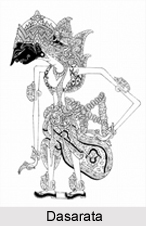 Dasarata are a group of performers who go about singing and dancing around the villages. This group of artists are known as Dasa`s. They earn their living by staging plays on festive occasions and jatras.
Dasarata are a group of performers who go about singing and dancing around the villages. This group of artists are known as Dasa`s. They earn their living by staging plays on festive occasions and jatras.
Origin of Dasarata
Among the village entertainers, the class or caste of Nattua is significant because it refers to the Community of actors. The Cheravu Belgal inscription of 1514 A. D. mentions a grant of land to the daughter of Nattuva Timmayya and to Nattuva Nagayya, evidently on the occasion of their marriage. The Kannada word Nattuva is commonly used in the village to this day, to indicate an actor.
Feature of Dasarata
Dasarata ata is not found either in Mysore or in South Canara. An important feature of Dasarata is its chorus consisting of both men and women singers, unlike in any other mode of the folk theatre including Yakshagana and Doddata. The performance is one in which both the Hennu Dasas (women) and Gandu Dasas (men) take part. The leading lady of the chorus later plays the role of the heroine. The hero of the play is called Goddi Bheemanna and the jester, Javari. There is no particular theme in Dasarata ata. After an invocation and introductory talking by Goddi Bhimanna, the show opens with a song and dance by a supporting female character. After her exit, the leading lady of the chorus enters in traditional costumes as the heroine and receives a great welcome from the chorus. After a song and a round of dance, she speaks to Goddi Bhimanna, the leading male member of the chorus. The conversation moves around the theme of love. The hero expresses his love quite crudely, and the heroine promptly rejects him; but the rejection is not precipitous as it only inaugurates the real drama of the keen argument between the hero and the heroine, each in support of his and her stand. Reels of songs and sayings including Javadi, Dasara pada, lavani and Vachana will figure in this long argument. The jester is always there providing a funny twist, a crooked turn or even a vulgar touch to the argument. The performance ends after a usual run for four or five hours without either the hero or the heroine giving in to the other. Dasara ata fulfils another fundamental demand of the theatre, for it has a collected audience to witness the performance and enjoy it. Still, it lacks a regular theme and framework, and hence, the prevailing proverb that Dasara ata is not a real ata.
Popularity of Dasarata
In spite of the proverb, the performance thrived for a hundred years and became so popular providing a wealth of entertainment, information and humour, that when teams of Dasara ata performers visited Maharashtra, it seems to have been readily accepted and adapted by the Marathi theatre stage. As a result, similar performances with the same characters and characteristics came up in Maharashtra with the name Tamasha. When in full swing, Tamasha became such a popular and powerful theatrical mode, that it assumed the role of the most successful medium of political and cultural propaganda in Maharashtra. In Tamasha, the Marathi version of the Kannada Dasara ata, the hero of the original Goddi Bhimanna came to be called Galfoji and the heroine Radha, The jester Javari came to be called Sakharam Tatya. Years later, when Tamasha became a charming entertainment both in the village and city, several such Marathi teams visited north Karnataka. Karnataka eagerly accepted it, adapted it into Kannada and renamed it as Radhana ata after the name Radha, the heroine of the Marathi theatre performance




